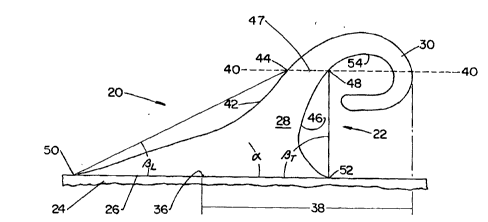Note: Claims are shown in the official language in which they were submitted.
58
What is Claimed:
1. A method for manufacturing one or more azimuthally angled prongs useful as
a component of a fastening system. characterized in that the method
comprises the steps of:
providing a depositing member having at least one cell, said cell having a
major axis and a minor axis, either said minor axis being oriented in a
direction other than the machine direction of said depositing member or said
cell has a dominant area on one side of the machine direction centerline;
providing a molten thermally sensitive material;
providing a substrate;
depositing a discrete amount of said molten thermally sensitive material from
said cell onto said substrate;
stretching a portion of said discrete amount of said molten thermally sensitive
material in a direction having a vector component parallel to the plane of said
substrate so as to form a prong, said prong comprising a footprint, a base, a
shank, and an engaging means, said footprint having either a major axis and a
minor axis, corresponding generally to said major axis and said minor axis of
the said cell or a dominant area on one side of the machine direction
centerline;
solidifying said molten thermally sensitive material of said prong so as to forma maximum lateral projection, said maximum lateral projection being oriented
either in a direction other than the direction of said major axis of said
footprint or generally toward said dominant area of said footprint, such that
said prong is azimuthally angled.
2. The method of Claim 1 additionally comprising the steps of transporting said
substrate in the machine direction.
The method of Claims I or 2 wherein at least one cell has an aspect ratio
greater than 1.5:1, preferably greater than 2:1, and more preferably greater
than 3 :1.
59
4. The method of Claim 3 wherein at least one cell has a substantially
rectangular, elliptical or triangular sectional area.
5. The method of Claim 4 wherein at least one cell as a triangular sectional area
comprising a first side and a second side which are equal in length, and a thirdside which is longer than said first side and said second side and is generally
parallel to the machine direction of said depositing member.
6. A method for manufacturing a fastening material have one or more
azimuthally angled prongs, characterized in that the method comprises the
steps of:
providing a depositing member having at least one cell, said cell having a
bottom surface comprising a first portion and a second portion, the depth of
said first portion being greater than the depth of said second portion, said first
portion being oriented relative to said second portion in a direction other thanthe machine direction;
providing a molten thermally sensitive material associated with said
depositing member;
providing a substrate;
depositing a discrete amount of said molten thermally sensitive material onto
said substrate;
stretching a portion of said discrete amount of said molten thermally sensitive
material in a direction having a vector component parallel to the plane of said
substrate so as to form a prong, said prong comprising a footprint, a base, a
shank, and an engaging means, said footprint having a first portion and a
second portion corresponding generally to said first portion and said second
portion of said cell; and
solidifying said molten thermally sensitive material of said prong so as to forma maximum lateral projection, said maximum lateral projection being oriented
away from said second portion of said footprint such that said prong is
azimuthally angled.
7. The method of Claim 6 wherein the ratio of the depth of said first area of said
cell to the depth of said second area of said cell is at least 1.1:1, preferably at
least 2: 1.
8. The method according to any of the preceding claims additionally comprising
the step of biasing said prongs prior to solidifying said molten thermally
sensitive material to assist in orienting said prongs.
9. A fastening material for attaching to a complimentary receiving surface, said fastening material manufactured according to the method of any of the
preceding claims.
10. An absorbent article comprising:
an outer cover comprising:
a topsheet; and
a backsheet joined with said topsheet;
an absorbent core positioned between said topsheet and said backsheet; and
a fastening material according to Claim 9 joined to said outer cover,
preferably to said backsheet.
